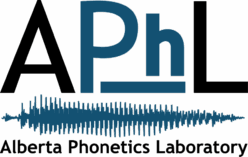Lab news
-
Research opportunities
Alert! We are recruiting volunteers who also have the option of enrolling in LING 375 Linguistics Directed Research I as a credit course. If you are interested, please send a short message and your CV to: aphl@ualberta.ca Here is a description of the ongoing projects to assist as a volunteer: The opportunity includes assisting…
-
Dr. Matthew C. Kelley
Congratulations to Dr. Matthew C. Kelley on successfully defending his thesis! Good luck with your new job at the University of Washington.
-
Congrats Dr. Sims
Congratulations Dr. Sims on successfully defending your dissertation!
-
Congrats Catherine, Grace and Chris!
Congratulations Grace and Chris on completing your degrees in linguistics! Congratulations to Catherine on completing her honors degree!
-
Gösta Bruce Scholarship
Congratulations Rebekka Puderbaugh on being awarded the International Phonetic Association’s Gösta Bruce Scholarship.
-
Congrats Atticus and Dylan
Congratulations to Atticus and Dylan on completing your Honors degrees!
-
Congrats Dr. Porretta!
Congratulations Dr. Vincent Porretta on completing your PhD!
-
Congrats Dr. Pham!
Congratulations Dr. Hien Pham on completing your PhD! Good luck at Vietnam National University.
-
Congrats Ryan!
Congratulations Ryan on completing your Masters of Science and getting accepted into the PhD program at the University of Canterbury!
-
Congrats Vince!
Congratulations to Vincent Porretta on completing his candidacy requirements!
